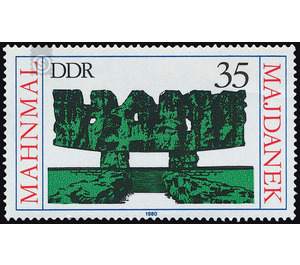Special stamp series International memorial and memorial places: memorial and memorial Majdanek / VR Poland - Germany / German Democratic Republic 1980 - 35 Pfennig
Theme: Architecture
| Country | Germany / German Democratic Republic |
| Issue Date | 1980 |
| Face Value | 35.00 |
| Color | green |
| Perforation | K 14 |
| Printing Type | Rotogravure 2 |
| Stamp Type | Postage stamp |
| Item Type | Stamp |
| Chronological Issue Number | 2280 |
| Chronological Chapter | GER-DDR |
| SID | 336058 |
| In 16 Wishlists | |
Majdanek Memorial Center / People's Republic of Poland As part of the series "International Remembrance and Memorial Sites", the Ministry of Posts and Telecommunications of the German Democratic Republic issues another multi-colored special postage stamp. The Majdanek Fascist Concentration Camp Majdanek concentration camp belongs to the concentration camps established by the German fascists during their dictatorship. It was named after the eastern quarter of the Polish city of Lublin. The instruction for the building gave in July 1941 the then Reichsführer SS Himmler. As Soviet POWs were also to be accommodated in the camp, it was set up for around 150,000 inmates. The detainees were people of various social, religious and political groups from more than 50 nations. The strongest grouping was the Poles. Almost all were political prisoners. The second largest group in terms of numbers was made up of Jews. Many prisoners had been taken from the USSR to Majdanek by Nazi occupiers. And during the so-called pacification of the fascists in the western areas of the Soviet Union, thousands of children and adolescents were snatched from their parents. They were also brought to Majdanek as were Jewish children from the ghettos of Warsaw and Bialystok. Most were escorted to the gas chambers as soon as they arrived. In the camp catastrophic living conditions prevailed. Lodgings were made up of leaking wooden shacks. One each was for 250 people. In most cases, however, up to 800 inmates had to find room in it. And the diet was kept to a minimum. The labor input of the prisoners had not only to bring the German imperialists profit, but the physical power of the already weakened people should be destroyed. Since there was no major industrial plant in Majdanek, some of the prisoners worked in factories and factories in the city of Lublin. Most, however, remained in the camp, built roads, dug trenches or had to toil in the various workshops. In addition to the heavy and exhausting forced labor, the cruelties of the camp went hand in hand. They expressed themselves in organized terror and in torture by the SS-Büttel. Even the slightest violation of the camp rules was punished with blows on the beating block. Particularly annoying was the standing between current-loaded wires. The detainees were killed by hanging, drowning and administering injections, shooting and gasification. The largest execution took place on 3 November 1943. On that day alone, 18,400 Jews were murdered. Majdanek was a cruel torture house with seven gas chambers, two crematoria and several outdoor corpse burning plants. The most commonly used was "Zyklon B" supplied by IG Farben. The results of the mass murder: According to documentary documents of the International Military Tribunal of Nuremberg, about 1,500,000 people perished in Majdanek. In the camp but also developed the resistance struggle. His forms were different. Often it began with comradely help to launch weak inmates into lighter task forces. There have been many attempts to connect with the outside world to learn and relay news and other important events. In cooperation with partisans who fought in the Lublin region in the back of the occupants, the members of the resistance movement in the camp designed a plan of self-liberation. The illegal organization "Adler" played a particularly active role here. The most effective form of resistance, however, was the organization of an escape. At the end of March 1944, the SS began evacuation of the Majdanek camp. The final eviction was resisted by an illegal committee formed of Polish and German prisoners. A group of these resistance fighters overwhelmed the SS guards on 24 July 1944 and handed them over to the Red Army. Thus it was ensured that the Soviet troops found the gas chambers and crematoria of this site of mass murder and horror intact. Today there is a memorial and memorial.


